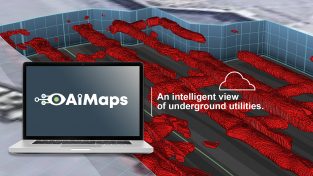In celebration of World Water Day and its theme of “Groundwater: making the invisible visible,” learn about the issues facing our groundwater supplies and how advanced technologies like Hexagon’s can help ensure a sustainable future.
22 March is World Water Day, celebrating water as a vital resource and raising awareness of the 2 billion people currently living without access to safe water worldwide. This year, the theme of the UN-observed holiday is “Groundwater: making the invisible visible,” an exploration of the importance of groundwater sources and the need to protect them as humanity’s demands continue to increase.
When we think of the Earth’s water resources, we tend to think of the vast oceans that cover 71% of the planet. That is a lot of water, but saltwater is extremely limited in its use to humans. Almost all of the liquid freshwater in the world, however, is groundwater. Stored in aquifers beneath the surface, groundwater is used for a multitude of human uses including sanitation systems, farming, irrigation, industry and our entire supply of drinking water. In drier parts of the world, this may be the only water people have any access to.
Unfortunately, the supply is both finite and fragile. Overuse and pollution are threatening groundwater supplies all over the world, and a rising global population (projected to reach 9 billion by 2050) will put further stress on these already strained systems. This does not apply to drinking water alone; an increase of 60 percent in food production will be necessary to sustain that many people, and over 40 percent of the water used to grow crops is sourced from aquifers. Climate change may further increase the danger, with changing rain and snow patterns affecting how quickly the aquifers can be refilled — if at all.
In order to keep a close eye on the conditions of groundwater systems, a lot of monitoring and data collection is required. The US National Geological Survey alone manages a system of more than 10,000 monitoring wells, constantly checking the levels and purity of water in aquifers. This creates a massive amount of data to process, and so far, the ability to use that data has lagged behind the need to act upon it. In fact, fewer than 2,000 of the USGS’ wells currently provide automated reporting of conditions.
Improving the current system will require significant technological upgrades, including new ways to integrate collected data regarding water quantity, quality, and usage to aid in predicting patterns and decision-making. That’s where the potential of autonomy becomes clear. Automation systems — like the ones provided by Hexagon — allow huge amounts of data to be collected, interpreted and integrated seamlessly without needing to rely on the limited number and time of human processing, allowing for smarter and more sustainable processes that react to changes in conditions as they happen.
Hexagon is already providing GIS tools to students and researchers to analyse and study polluted runoff and its effects on groundwater supplies, and municipal systems utilizing solutions — such as HxGN Connect — will be able to share data seamlessly between agencies to reduce delays and act quickly to find and contain pollutants before they can further contaminate local aquifers. The possibilities provided by this level of integration are many: imagine if specialised collection sites could autonomously make use of weather data and collect rainwater to be pumped immediately where it is needed, or if facilities producing significant pollution could be identified without the need for an inspection team. Smarter technology not only makes these things possible — it makes them more sustainable.
This World Water Day, take a minute to examine the way you use water, minimise your impact when possible, and remember that the way we treat our planet today is vital in building a better future.

















